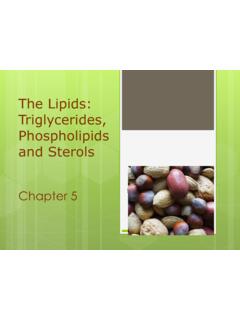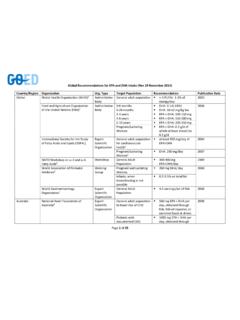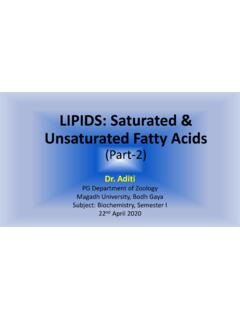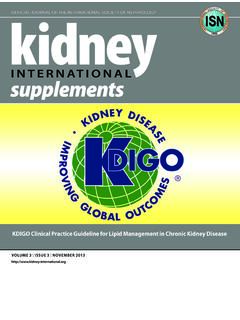Transcription of Lipids and Carbohydrates - Rochester City School District
1 1lipidsphospholipidsdisaccharidesinclude triglyceridesincludepolysaccharidesmonos accharidescarbohydratesUnit xx, Lesson xxUnit xx, Lesson xxLipids and Carbohydrates Essential Questions What are the solubility characteristics and functions of fats and phospholipids? How do the structures of starch, glycogen, and cellulose differ? What are the consequences of base additions, deletions, and substitutions on a molecule of DNA?Unit 7, Lesson 2 Keywordscarbohydratecellulosechitindisac charideglucoseglycerolglycogenisomerslip idphospholipidpolysaccharidesaturated fatty acidstarchtriglycerideunsaturated fatty acidCopyright 2011, K12 Inc. All rights reserved. This material may not be reproduced in whole or in part, including illustrations, without the express prior written consent of K12 7, Lesson 2 Lipids and Carbohydrates 2 Set the StageDifferent types of Lipids have different impacts on human health.
2 Saturated fats, including artificially saturated trans fats, have the ability to raise bad cholesterol (LDL or low-density lipoprotein) levels and lower good cholesterol (HDL or high-density lipoprotein) levels, building up fatty material in arteries. Over time, plaque ruptures and blood clots can occur, at times clogging arteries. Plaque ruptures and blood clots in arteries feeding the heart or brain often cause a heart attack or stroke. Since heart disease and stroke are among the leading killers of adults in the United States today, people are giving much attention to contributing factors in this the flip side, unsaturated fats, in particular monounsaturated and polyunsaturated fats, have the opposite effect on blood cholesterol levels.
3 When eaten in moderation, these fats help lower LDL levels, thus reducing risk of heart disease. Polyunsaturated fats include omega-3 fatty acid. It is a type of essential fatty acid, meaning that our bodies cannot produce it, so it must be ingested. Omega-3 fatty acids play a role in healthy brain function, growth, and development. Generally, it is the quantity and type of fats eaten that affects health. The right kinds of fats are essential to life. As our knowledge about fats continues to grow, especially at the molecular level, so will our basic understanding of correlations between diet and health, and many lives can be saved. Lipid macromolecules are made of glycerol and fatty are a class of macromolecules that includes fats, phospholipids, and steroids.
4 Lipids are central to several major biological functions, including energy storage, cell membrane structure, and hormone in other macromolecules, the molecular components of a basic lipid are responsible for the unique functions of lipid macromolecules. Lipids are made up of several smaller molecular structures such as glycerol and fatty is an alcohol with three carbons, each attached to an OH. A fatty acid is a long chain of carbons, typically 16 or 18 in length, with hydrogen atoms attached to each carbon and a carboxyl functional group at one end. The carboxyl group on the fatty acid is the portion of the fatty acid that undergoes the dehydra-tion synthesis reaction with glycerol.
5 Fatty acids are nonpolar: they have no negative or positive end. Carbon and hydrogen atoms in fatty acids have approximately the same electronegativity, meaning that they share electrons equally between each other. Water molecules, by contrast, are polar: they have positive and negative sides. Polar molecules do not mix with nonpolar molecules. Therefore, Lipids separate into a separate layer when mixed with water. glycerol an alcohol with three carbons each attached to a different hydroxyl grouplipid a macromolecule composed of fats, oils, phospholipids, steroids, and waxesCopyright 2011, K12 Inc. All rights reserved. This material may not be reproduced in whole or in part, including illustrations, without the express prior written consent of K12 7, Lesson 2 Lipids and Carbohydrates 3 Triglycerides are a commonly occurring one glycerol molecule bonds covalently to three fatty acids through dehy-dration synthesis, the product is a triglyceride (Figure 1), a lipid commonly referred to as fat.
6 Depending on the particular structure of the fatty acids forming a triglyceride, different triglycerides have different that are solid at room temperature, such as butter, lard, and other ani-mal fats, are called saturated fatty acids. In these fatty acids, all carbons that can possibly bond to hydrogen are bonded, so the molecule is saturated with hydrogen molecules. Saturated fat molecules can stack tightly together, which means that they require higher temperatures to melt and are typically solid at room temperature. Fatty acids also commonly contain double bonds between carbons. When a fatty acid contains one or more double bond and thus cannot be saturated with many hydrogen molecules, it is called an unsaturated fatty acid.
7 Unsaturated fatty acids are typically liquid at room temperature because double bonds form large kinks in the fatty acid tails and prevent unsaturated fatty acid molecules from stacking tightly together. When the molecules are farther apart, unsaturated fats reach a liquid state at lower temperatures, compared to their well-compacted saturated fat counterparts. Unsaturated fats are typically oils. They are considered healthier to eat than saturated fats and are naturally found in plants and fish. Omega-3 is a fatty a glycerol attached to three fatty acids; also called a fatsaturated fatty acid a triglyceride with no double bondsunsaturated fatty acid a triglyceride that contains double bondsHCHHCHHOCOCHHCHHCHHCHHCHHCHHCHHHCHH CHHCHHCHHCHHCHHCHHCHHCHOCOCHHCHHCHHCHHCH HCHHCHHHCHHCHHCHHCHHCHHCHHCHHCHHCHHOCOCH HCHHCHHCHHCHHCHHCHHHCHHCHHCHHCHHCHHCHHCH F igure 1.
8 A triglyceride consists of one glycerol molecule covalently bonded to three fatty 2011, K12 Inc. All rights reserved. This material may not be reproduced in whole or in part, including illustrations, without the express prior written consent of K12 7, Lesson 2 Lipids and Carbohydrates 4 Phospholipids are another commonly occurring lipid. Another type of lipid is a phospholipid, made up of a glycerol molecule bonded to only two fatty acids instead of three, like triglyceride. Instead of a third fatty acid, a phospholipid contains a phosphate molecule that is covalently bonded to the third hydroxyl functional group on the glycerol. This phosphate group, unlike the fatty acids, does not share electrons equally with its various atoms and is therefore slightly electronegative and capable of forming polar covalent bonds with other molecules.
9 These polar covalent bonds result in areas of the phospholipid that are partially charged and hydrophilic. They interact with water molecules. Therefore, the fatty acid part of the phospholipid macromolecule is hydrophobic while the other part, the phosphate group, is hydrophilic. The unique combination of hydrophobic and hydrophilic chemical properties makes the phospholipid molecule the ideal component for cellular membranes. When placed in water, phospholipids assemble themselves into two layers, or bilay-ers, with the fatty acid tails clustered inward away from water and the phosphate groups outward, where they are exposed to water (Figure 2). This arrangement is ideal in cell membranes since both intracellular and extracellular fluids are aqueous.
10 Carbohydrates include monosaccharides and carbohydrate is a molecule composed of carbon, hydrogen, and oxygen in the ratio of one carbon and oxygen atom for every two hydrogen atoms, or one car-bon for every H2O molecule. The name carbohydrate is therefore very appropriate. Carbohydrates vary in complexity ranging from simple monomer sugars to complex polymers like starch, glycogen, and cellulose. Carbohydrates are ubiqui-tous in the plant and animal kingdoms, and, as with the other macromolecules, we are dependent on them for a glycerol bonded to two fatty acids and one phosphatebilayerphospholipidhydrophobic tailshydrophilic headFigure 2. Phospholipids assemble in bilayers in the presence of water, with their hydrophobic fatty acid tails clustered inwards and the hydrophilic heads facing outwards, exposed to a macromolecule composed of large organic molecules made from carbon, oxygen, and hydrogenCopyright 2011, K12 Inc.


















